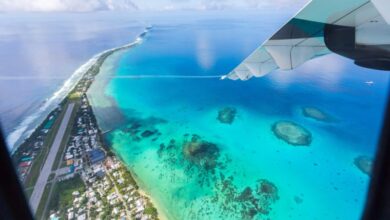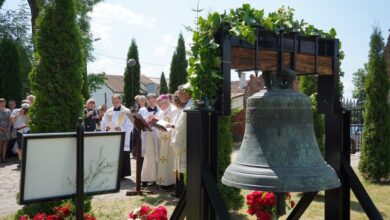Shroud of Turin gets ‘true crime’ treatment in science-driven documentary
 Filmmaker Robert Orlando, standing before a negative image of the Shroud of Turin, says he was prompted to investigate the purported burial cloth of Jesus in part because of a search to answer "big questions" about life and faith following the death of his father. / Courtesy of Nexus Media
Filmmaker Robert Orlando, standing before a negative image of the Shroud of Turin, says he was prompted to investigate the purported burial cloth of Jesus in part because of a search to answer "big questions" about life and faith following the death of his father. / Courtesy of Nexus Media Napa, California, Jul 29, 2023 / 16:55 pm (CNA).
In 1988, carbon-dating tests concluded the Shroud of Turin was a 700-year-old fake. Thirty-five years later, 21st century science is pointing to a dramatically different conclusion.
The carbon tests overseen by the British Museum and Oxford University have since been discredited. For reasons not fully explained, researchers analyzed only a small fiber sample taken from an edge of the shroud that was damaged in a fire in 1532 and mended by Poor Clare nuns using dyes.
Meanwhile, ever more sophisticated tests of the cloth’s pollen, bloodstains, and its perfect three-dimensional imagery are producing mounting evidence that the Shroud of Turin was created in the 1st century by a “nuclear event” that can’t be replicated by today’s technology.
Filmmaker Robert Orlando dives into the middle of the debate over the shroud’s origins and authenticity with a new documentary, “The Shroud: Face to Face,” set for release in November.
Orlando, who has written a book by the same title, frames his subject as a contemporary “true crime” investigation, employing recreated scenes and edgy visual effects to give the film an artsy vibe.
The film features interviews with experts from both sides of the debate, including American historian and Princeton Theological Seminary professor Dale Allison, Cheryl White of the Shroud of Turin Education and Research Association, and Mark Goodacre, television director, New Testament scholar, and professor at Duke University’s Department of Religion.
Father Andrew Dalton, LC, STD, professor of theology at the Pontifical Athenaeum Regina Apostolorum in Rome, who wrote the foreword for Orlando’s book, also appears in the film, as does Father Robert J. Spitzer, SJ, the Jesuit scholar, author, and popular EWTN television host.
Reaching a new audience
On Friday night, July 28, Spitzer joined Orlando for a 15-minute sneak peek of the film followed by a question-and-answer session during the Napa Institute’s annual summer conference in Napa, California. Spitzer is the institute’s president and co-founder.
“It’s more than a documentary in the sense that it engages everything: the aesthetic sense, the excitement of the investigation, the multimedia, all the senses,” Spitzer said of the film.

Spitzer hopes Orlando’s work will introduce the Shroud of Turin to a “whole new audience” that’s unlikely to visit a shroud museum or read a scholarly book on the subject.
“This is the way, I think, to get the message out, and in a compelling way that doesn’t force people, that allows them to make a decision for themselves,” said the host of EWTN’s “Father Spitzer’s Universe.”
Orlando said he agreed to make the documentary since the shroud seemed to be “in the air” now, with new exhibits opening in Houston and Washington, D.C., among other locations.
But he also saw the film’s investigative process as part of a more personal quest for answers to life’s “big questions” after the recent death of his father.
“I was trying to combine the two,” Orlando explained. “I didn’t know where they were blended together, but it was the right project at the right time.”
A relic of the Resurrection?
Recent scientific discoveries discussed in the film include the finding that the man on the shroud suffered head wounds caused by a “helmet” of thorns, something a medieval forger isn’t likely to have imagined, since the Gospels refer only to a “crown of thorns.”
Also, the man’s right shoulder is lower than his left, which Spitzer says is consistent with a shoulder dislocation, likely from a fall. This would explain why Roman soldiers would have forced a bystander like Simon of Cyrene to help carry Jesus’ cross, he noted.

Another compelling finding is that most of the pollen fossils left on the shroud come from northern Judea, not France or other places where the cloth is known to have been over the past 700 years.
“So, it has to be much older,” Spitzer reasoned.
Based on his research over the years, Spitzer is convinced of the shroud’s authenticity. He subscribes to the theory that “low-temperature spontaneous nuclear degeneration” of every cell in the crucified man’s body created an incredibly intense burst of radiation that left behind physical evidence of the Resurrection.
Orlando, for his part, demurred when asked about the film’s conclusions, preferring to let viewers watch his investigative journey unfold.
“I think if I did my job, at the end, someone will (encounter) the man Jesus,” he said, “and have to answer the question, ‘Who do you say I am?’”
More details about the film are available here.






